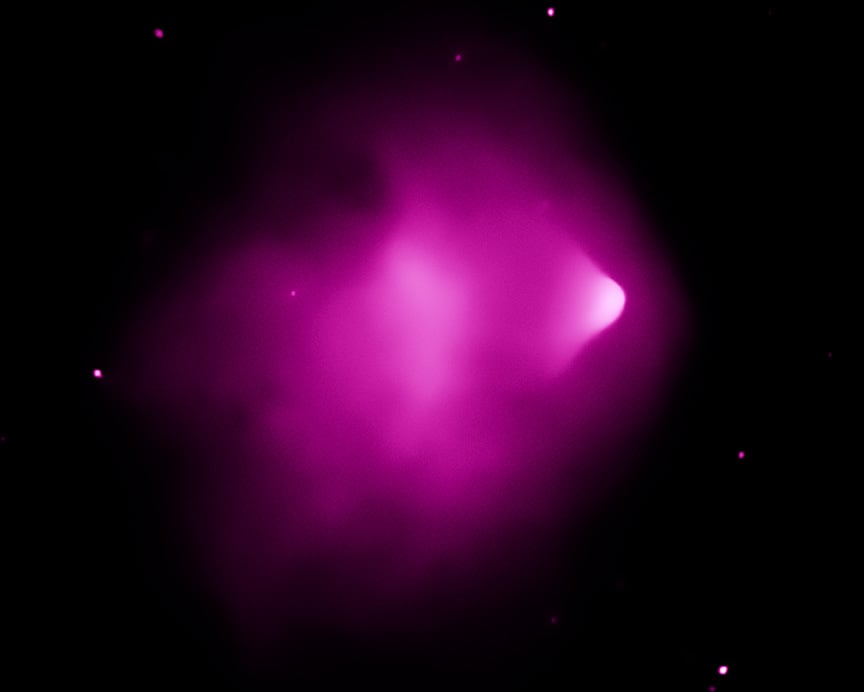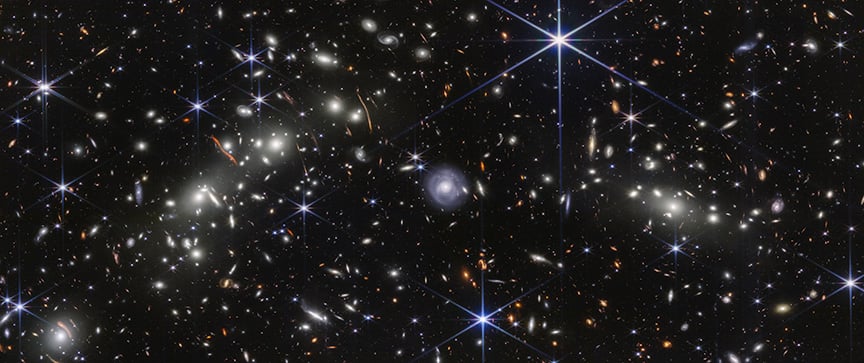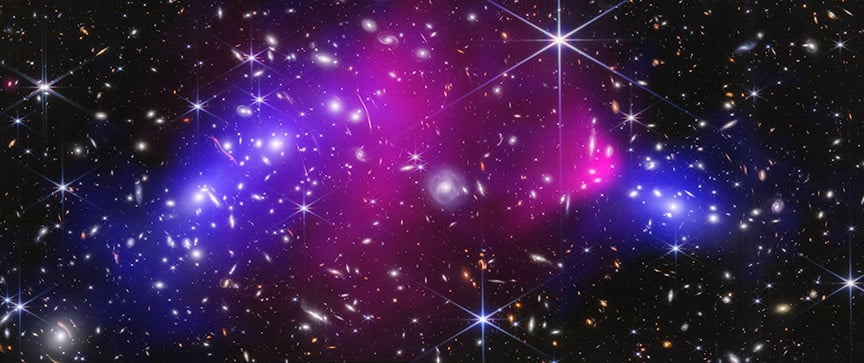One of the most iconic cosmic scenes in the Universe lies nearly 3.8 billion light-years away from us in the direction of the constellation Carina. This is where two massive clusters of galaxies have collided. The resulting combined galaxies and other material are now called the Bullet Cluster, after one of the two members that interacted over several billion years. It’s one of the hottest-known galaxy clusters, thanks to clouds of gas that were heated by shockwaves during the event. Astronomers have observed this scene with several different telescopes in multiple wavelengths of light, including X-ray and infrared. Those observations and others show that the dark matter makes up the majority of the cluster’s mass. Its gravitational effect distorts light from more distant objects and makes it an ideal gravitational lens.
Astronomers pointed the infrared-sensitive James Webb Space Telescope (Webb) to view the Cluster in part to help refine its mass. The Bullet is actually two clusters, a smaller sub-cluster called the Bullet, and the larger one it collided with in the past. The observations provided extremely detailed images of the cluster’s galaxy members, as well as a view of hundreds of other faint ones that lie beyond. They also mapped the distribution of hot gas, which appears to be in separate “blobs”. Those gaseous regions helped them learn more about the distribution of dark matter in the cluster. “With Webb’s observations, we carefully measured the mass of the Bullet Cluster with the largest lensing dataset to date, from the galaxy clusters’ cores all the way out to their outskirts,” said Sangjun Cha, the lead author of a paper published in The Astrophysical Journal Letters. Not only that, but the Webb view also allows scientists to study the distant galaxies “behind” the cluster in great detail. Their distorted images also give clues to the distribution of dark matter in the lens.
This image shows the different wavelengths at which scientists studied the Bullet Cluster using JWST’s NIRCam instrument. The circles show the two clusters (in blue with their hot gas clouds in red). The one on the left shows an elongated shape, which suggests it’s been through more than one collision. Credit: NASA, ESA, CSA, STScI, CXC
“Webb’s images dramatically improve what we can measure in this scene — including pinpointing the position of invisible particles known as dark matter,” said Kyle Finner, a co-author and an assistant scientist at IPAC at Caltech in Pasadena, California. Dark matter plays a role, not just in the Bullet Cluster’s hot gas clouds, but also in the light from distant galaxies passing through and around the cluster.
What Happened with the Bullet?
When you look at the combined infrared and X-ray views of the Bullet Cluster, among other things, you see those blobs of hot gas. One is in the form of a bow shock whipped up when the smaller sub-cluster member passed through the larger galaxy cluster. That sent the temperature of the gaseous regions up to millions of degrees, which released X-ray emissions detectable by Chandra.
 A Chandra X-ray view of hot gas clouds in the Bullet Cluster. This one gives the cluster its distinctive name. It lies entirely separated from the dark matter in the cluster. This indicates something about how dark matter behaved in the collision. Credit: X-ray: NASA/CXC/SAO
A Chandra X-ray view of hot gas clouds in the Bullet Cluster. This one gives the cluster its distinctive name. It lies entirely separated from the dark matter in the cluster. This indicates something about how dark matter behaved in the collision. Credit: X-ray: NASA/CXC/SAO
To understand why astronomers find the Bullet Cluster so fascinating, it helps to understand how it got the way it appears in Chandra and Webb observations. Well more than four billion years ago, these two galaxy clusters began a close approach. Both clusters were rich in stars, gas, and dust. Like the rest of the Universe, they were permeated with dark matter. Eventually, the two clusters collided. The stars were largely “unhurt” by this, other than perhaps having their velocities through space slightly altered. The collision basically caused a separation of the hot gas and dark matter. The gas, being affected by ram pressure (caused by something moving through the interstellar/intergalactic medium), slowed down due to the collision. The dark matter, which interacts primarily through gravity, passed through without any problem. This separation provided key evidence for the existence of dark matter. “As the galaxy clusters collided, their gas was dragged out and left behind, which the X-rays confirm,” Finner said. Webb’s observations show that dark matter still lines up with the galaxies — and was not dragged away.
What the Cluster’s Gravitational Lens Reveals
While we can’t see the dark matter at all, its presence around and within the Bullet Cluster’s galaxies turns it into a giant gravitational lens. Think of it as a cosmic magnifying glass that shows otherwise unseen things. It also does something remarkable: “Gravitational lensing allows us to infer the distribution of dark matter,” said James Jee, a co-author, professor at Yonsei University, and research associate at UC Davis in California. Jee suggests that we think of this gravitational lensing as working the same way that water in a pond magnifies the view of things in the pond. “You cannot see the water unless there is wind, which causes ripples,” Jee explained. “Those ripples distort the shapes of the pebbles below, causing the water to act like a lens.”
That lens reveals thousands of distant galaxies whose light is “smeared” and distorted by the gravitational effect of the dark matter lens. The distribution of those galaxies across the lens also helps astronomers map the distribution of the dark matter that makes it up.
 The Webb NIRCam view of the Bullet Cluster, showing an infrared look at distant galaxies, with their images deformed by the gravitational effect of the dark matter. Credit: Near-infrared: NASA/ESA/CSA/STScI; Image processing: NASA/STScI/J. DePasquale
The Webb NIRCam view of the Bullet Cluster, showing an infrared look at distant galaxies, with their images deformed by the gravitational effect of the dark matter. Credit: Near-infrared: NASA/ESA/CSA/STScI; Image processing: NASA/STScI/J. DePasquale
Now that astronomers know where that dark matter is distributed in the cluster, the images and data also show that the particles (no matter what they’re made of) don’t affect each other beyond whatever gravitational attraction they have toward each other. It implies that they act independently of each other. Now the trick is to figure out what kind of particles act as dark matter has been observed to do. Webb’s observations also show that dark matter still lines up with the galaxies — and was not dragged away during the chaos of the cluster collisions. These new observations place stronger limits on the behavior of dark matter particles.
For More Information
NASA Webb ‘Pierces’ Bullet Cluster, Refines Its Mass
A High-Caliber View of the Bullet Cluster through JWST Strong and Weak Lensing Analyses
